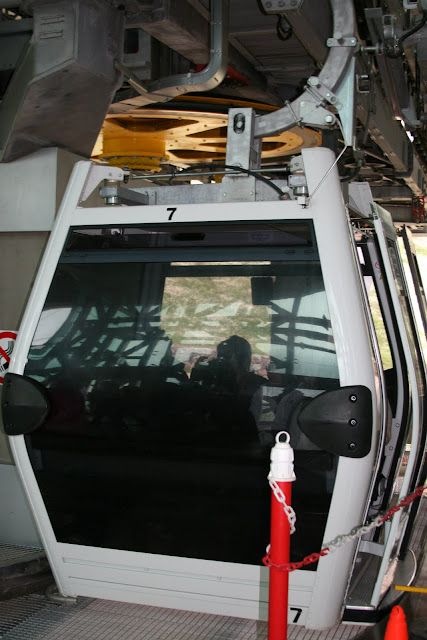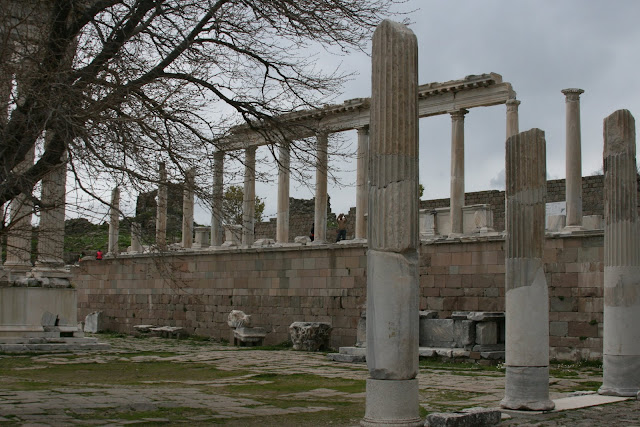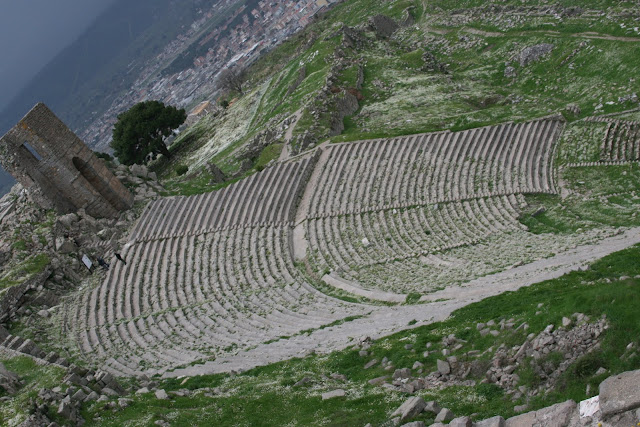What is left of the once great city of Pergamon, are now the ruins . We rolled into the sleepy town , past rows of houses, their rooftops peeping up along the sides to watch us go. The rains threatened to spill over any moment as we stepped out of our tour bus and beneath the canopy of grey we took the cable car to this beautiful archaeological site .
I hadn't read enough and even if I had I don't think I would remember , as this place had history spilling over from every corner of this arresting ruin . For a while I just shut off , as our guide spoke on and let myself soak up the incredible sights and sounds around me .
 |
| The cable car to the site.. |
A sea of daisies , an ocean of white rises and falls with the blowing winds. Beyond we see the village of
Bergama as it is now and the two images stand side by side as if to remind us that all cities transition into nothingness as the relentless wheel of time soldiers on.
 |
| First sights... |
The landscape is draped in white, stone peeping out and breaking the surface in stubborn defiance of being buried and forgotten.
"We still remain", they seem to say though we are not what we were once.
 |
| The archeological site of Pergamon |
 |
| Exploring the ruins.. |
History
History has a long arm, reaching out towards time itself. Only parts of stories that make up this place are known, some fact and some legend. At its Zenith,
Pergamon stood capital to the
Attilad kings of the
Pergamon empire somewhere in the 2nd century BC and later in the Roman period was the capital of the Asian province. From then the site has seen a succession of kings and princes, rulers and dynasties, its influence waxed and waned and finally went into steady decline with the arrival of Christianity when the site was considered home of the Pagan Gods.
Pergamon and the Bible..
Pergamon finds mention in the Book of Revelations as one of the seven churches of Asia. We pass what is a white stone with inscriptions of what we are told are the words of Jesus Christ.
I stare at the letters and imagine a world where we still had some of these beautiful characters as part of our alphabet, though some like the As and Ps tempt me to read them out loud. What come out of my mouth are alien sounding words , clearly wrong :)
 |
The white stone at Pergamon with inscriptions of Christ - "And to the angel of the church in Pergamos write.He that hath an ear, let him hear what the Spirit saith unto the churches; To him that overcometh will I give to eat of the hidden manna, and will give him a white stone, and in the stone a new name written, which no man knoweth saving he that receiveth it" (Rev 2:12, 17).
|
The Altar of Pergamon
In the middle of the site stands what was once the great altar of
Pergamon, built by the Greeks in the 2nd century BC in honour of the Greek god Zeus. Excavated by German archaeologist
Carl Humann in the 19th century, All that remains now is the base. The altar was shipped out by his team and sits in a museum in the
Pergamon museum in Berlin.
Our guide talks about the countless instances such as this , when historical artifacts were stolen and poached and now sit in museums in Germany, France and Britain . While it is great that museums preserve important relics for posterity, this need cannot justify acts such as these. What would be a better way to see them than in the midst of these incredible ruins, their rightful home?
Almost in parallel, I also remember reading about a Banksy painting , bought in an auction .
The people of the town campaigned against the painting being moved as hey felt it was part of their heritage . Now how different is this from the requests of other counties asking for part of their heritage to be returned, like for instance the Kohinoor (One of the largest diamond in the world , now part of the crown jewels, shipped out of India during the British colonial rule ) ? Colonialism lives on even if through these ruins
 |
| The remains of the great altar of Pergamon.. |
The Amphitheater
When the guide said vertigo inducing, I thought this was just another word that becomes part of the cliched trousseau of adjectives that describe a breathtaking sight. But staring down at this beautiful BEAUTIFUL structure I could imagine the roar of the 10000 strong crowd it could house and it did make my head spin. Built during the hellenistic period, it was altered by the Romans. Stones lay strewn along the hillside where the theater grows and over the years the grass seems to have silently grown over the proud structure

We finally walk through a maze of alleyways , when the rain beings to pour.
They look like damp cells, but this was once some sort of market place.

Like an old man well past his prime , whose eyes shine in memory of a life well lived, Pergamon sits quietly proud atop its hill top perch. As we walk away from this place of a thousand stories, we wave goodbye to the history that still lingers on.
Meena